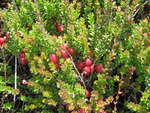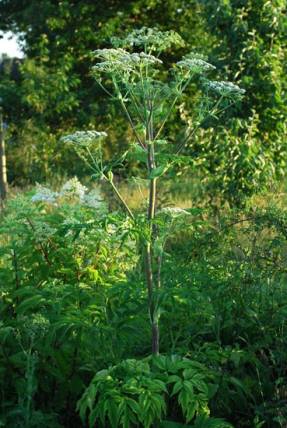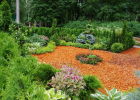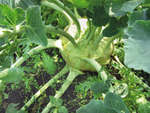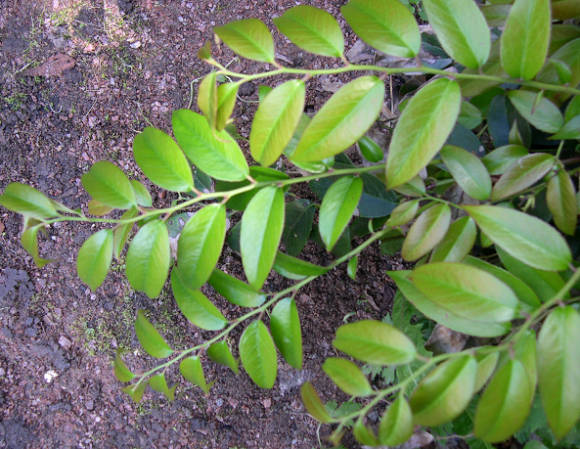Despite the fact that Sandersonia is a rather spring-like plant with cheerful orange flowers, in its homeland in South Africa, it is called the Christmas bell or the Golden Lily (previously the plant was referred to the lily family). Of course, this is no coincidence - the bloom of Sandersonia in the wild falls on the period of the Christmas holidays (from late November-mid-December to January), and the bizarre flowers, in color and shape, remind of the gold of bells. But the origins of the name may be different.
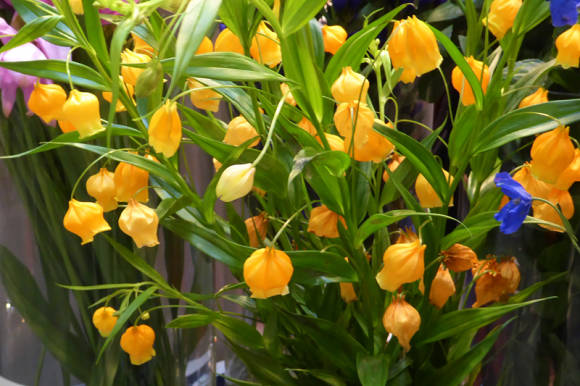
This plant was discovered in the South African province of KwaZulu-Natal (the province of Natal used to bear the Portuguese name "Christmas") relatively recently, in 1851. Its discoverer was the English botanist John Sanders. And William Hooker, who described the plant, immortalized the name of Sanders in its name.
It seems to me that Sandersonia is a bit like Triandrus daffodils, the flowers of which consist only of a crown and are devoid of petals. When you occasionally meet Sandersonies on sale in winter, it seems that they carry the breath of spring, which after the New Year we begin to wait with great impatience. From here, probably, its English-language name Golden Lily of the Valley also appeared. And the bloated shape of the flowers has determined another name - Chinese lanterns (not to be confused with physalis).
Once upon a time, Sandersonia grew en masse in meadows, wet slopes and forest edges in several provinces of South Africa. Today it is a rare protected endemic in its homeland, and it can be found only in protected areas. But industrial cultivation has been established in New Zealand (since the 90s of the last century, this is the second export item for cuttings after orchids), the Netherlands, and Japan.
Sandersonia orange (Sandersonia aurantiaca) - the only and unique representative of the Sandersonia genus in the timeless family (Colchicaceae)... Endemic to South Africa.

This plant has straight or almost straight stems up to 1 m in height. The underground organ of the plant is a fork-shaped tuber with one bud at the end of each lobe. Deep roots and stolons extend deep into the root at the base of one of the mature lobes, on which new small tubers develop. Each mature bud produces a single graceful stem in spring. The leaves on the stems are arranged alternately, few in number, narrowly elliptical, equipped with a tenacious tendril at the top, dark green. Flowers can be of different shades - from pale yellow to bright orange. They are located along the stem in the axils of the leaves, drooping, on thin long pedicels, elegantly shaped, similar to swollen lanterns with several folds in the upper part and a "ruffle" along the edge. The flowers bloom from the bottom up, making the flowering period quite long. The fruit is a multi-seeded capsule, the seeds are hard and brown in color.
Sandersonia tubers contain the poisonous substance colchicine, like those of its close relatives - gloriasis and colchicum. Despite the fact that the local population of Africa has long used them as an aphrodisiac, you should not taste the tubers, and work with the plant with caution.
Growing Sandersonia at home
Sandersonia orange naturally grows on deep, heavy, moist soils in the open sun. We can only grow it as a house or greenhouse plant. Potted plants that occasionally appear on the market are more compact than natural ones, they are much lower than a meter - up to 50-60 cm.
Grow pots... For sandersony, deep plastic pots with a diameter of about 25 cm are needed. Only in this way will the deep root system of the plant feel comfortable.
Priming... The soil for planting is taken universal, well-drained (containing coarse river or quartz sand, or perlite), which will contribute to good aeration of the soil.The soil should not be poor - about a quarter of well-rotted compost or Biohumus is added to it according to the instructions. The reaction of the soil should be slightly acidic (pH 5.5-6.5).
Landing... Expanded clay is placed at the bottom of the pot or for drainage with a layer of 2-3 cm, two-thirds of the pot is filled with soil, leveled, washed sand is poured with a layer of 1-2 cm.A support for the antennae of future plants is inserted into the center and 3-5 tubers are laid horizontally around it. This should be done with caution, because planting material is fragile. Finally, they fall asleep almost to the top with an earth mixture.
Watering... Planting is watered sparingly until leaves appear. Then watering is carried out once a week by soaking the root ball for several minutes in water.

Temperature... Tubers are germinated at a temperature of + 20 ... + 25 ° C. During the rest period, they are kept in cool conditions, at + 3 ... + 5 ° C. The rest period must be at least 12 weeks.
Lighting... Sandersonia requires good bright but diffused light. It can be in the direct sun only in the morning, it should be shaded at noon. In winter, it requires additional lighting with a phytolamp.
Top dressing... Sandersonia is very fond of phosphorus and potassium, so potassium monophosphate will be the best fertilizer for her. It is brought in in the middle of summer and before flowering. And in the initial period of development, you should take a complex nitrogen-containing fertilizer.
Storage of tubers. After flowering, when the aerial part dries up, the tubers are stored in a cool place (+ 3 ... + 5оС), sprinkled with a dry earthen mixture, the same as for cultivation. The tubers can be stored under the same conditions until the spring transplant.
Breeding Sandersonia
Sandersonia orange can be propagated by seeds, by dividing tubers, and in industrial floriculture, clonal micropropagation in vitro is successfully used.
Seed propagation hindered by prolonged and uncooked germination. They are harvested in spring and sown freshly harvested in deep trays. Placed in a semi-shaded place and watered from a spray bottle. A small number of seeds germinate in the first year. With the onset of autumn, the soil is allowed to dry out and placed in winter storage.
At the end of the next spring, watering is resumed and seedlings appear en masse. Plants that have risen last year can be planted, they are able to bloom by winter. But usually seedlings bloom in the 3rd year.
So you can get seedlings from one tray for 2-3 years, the remaining seeds will continue to germinate.

Germination can be accelerated by cold stratification. The seeds are soaked for a day, then mixed with vermiculite and placed in a refrigerator at + 5 ... + 6 ° C for 3 months. Then they are sown in the spring. The stratification procedure can be replaced by bubbling in water to saturate with oxygen, or by scarification, i.e. violation of seed shells (for example, sandpaper).
Vegetative propagation... The main method of reproduction is still vegetative reproduction, it is this that ensures the uniformity of the color of flowers and the habit of plants.
When transplanting, young tubers are separated, formed on stolons at the base of the stem.
Large, ripe tubers can be divided. A forked branched tuber at the end of winter is cut in half with a sharp knife, the cut is dried for 1-2 days and the cut is treated with a fungicide (Maxim, Fundazol). Planted horizontally. During the summer growing season, the old tuber dies off, a new root system and shoot are formed. An interesting detail - of the two separated parts, only one germinates, but at the same time the plant rejuvenates.
Finally

Pests and diseases... Pests do not annoy Sandersonia, probably because of its toxicity. Sometimes aphids may appear in early summer. Of the diseases, rotting of tubers caused by fungal pathogens is most likely. Compliance with cultivation techniques, soil composition guarantees no problems.
About plant protection - in the article Houseplant pests and control measures.
Cut... Sandersonia is a sunny, joyful flower that perfectly decorates bouquets and compositions.Well (2 to 3 weeks) the cut is in the water. It is with this that the plant fell in love with florists and became the subject of mass cultivation for cutting.
When cutting, leave 4 lower leaves so as not to disturb the possibility of tuber development. At this point, 2 to 4 flowers should be open on the stem.

